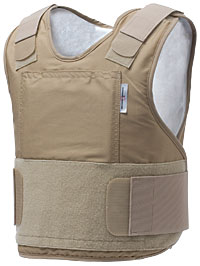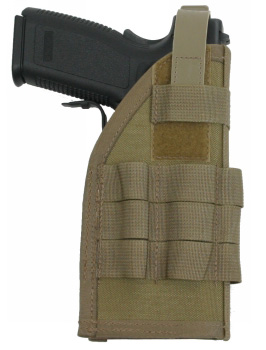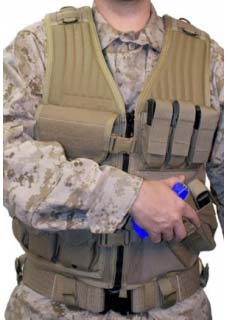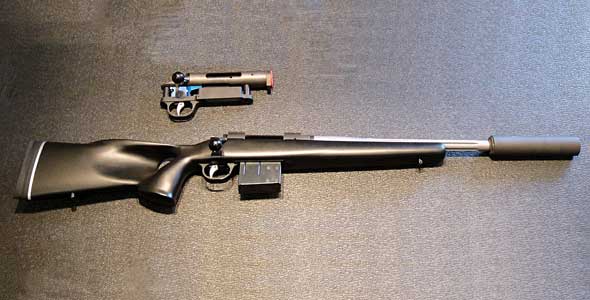Gear Up for Home Defence
With the rise in violent, armed home invasions over the past couple of years, the idea of having something handy that will contain all the necessary items one might need to ‘repel boarders’ in the middle of the night has become more and more mainstream.
Citizens who take their personal security seriously have come to realize that it might well take more than a pair of flip flops, a cheap hardware store torch and the trusty old handgun to stop a determined and quite possibly very well armed (exactly where did all those missing SAPS R5’s go again?) group of violent home invaders who make entry knowing full well people are at home.
Gear such as vests, plate carriers or magazine pouches / holsters, etc. will naturally follow your personal plan for home defense as well as the weapons you may have at your quick disposal. If all you have is your handgun, then that is what you need to support. Ditto for better weapons such as shotguns or rifles. It really does not matter what you may have in the safe, since you are not likely to be able to get it open and the gun(s) loaded, and ‘gear up’ in time to be a serious player in this ‘game’.
Much may also depend upon your location. If you are on a relatively isolated farm out in the boonies or even a small holding closer to civilization, you may need more or different gear from the guy who lives in an upscale area of homes and flats, etc. In the end, you must make your own choices as to your tools, gear and plans, but hopefully this article will be of some use in that selection process. If nothing else, perhaps it will make you think a bit more deeply about your situation and plans.
Possibly the nearest thing to a gear set up for home use in the professional world would be some of the various ‘Active Shooter’ rigs used by US law officers, although some of these will be used to carry more and / or different items than a home owner would normally need.
Active Shooter is the term used to generally describe a critical incident where there are one or more goblins moving through a structure or area (Mumbai) gunning down pretty much everyone they can shoot. They are mobile but almost always on foot, and they are not really trying to escape or hide from responding officers. The catalyst for this program was, of course, the school shootings at Columbine High School in 1996.
At that time, the prevailing policy for LEOs was to respond to the incident, set up a perimeter and command post and wait for SWAT to make entry. This policy is still followed when the situation is a barricaded gunman or a hostage incident, etc. and for those situations it works as designed. At Columbine it allowed two shooters to continue killing and wounding innocent kids and teachers while officers waited outside. Thus was ‘Rapid Response to Critical Incidents’, or Active Shooter for short, born.
Other incidents since Columbine have shown that even waiting for a ‘scratch team’ of officers to form up and go in can take too long…the most obvious one being the Virginia Tech shootings in April of 2007, where the shooter chained doors shut and locked a large classroom before he started killing. Today, officers are generally taught to make immediate entry, even if alone, since statistics show that as soon as an active shooter is confronted at close range by armed resistance most either flee or shoot themselves, since it is usually a suicide mission for them anyway.
This, in turn, has lead to many officers putting together an ‘active shooter rig’ that can quickly be slipped on over the uniform and that holds the gear most likely to be needed to survive a relatively short, fast fight inside a building…very similar to the armed home invasion scenario with the exception that there will seldom be more than two shooters involved. (Mumbai, while definitely an active shooter scenario, was much different)
Most cops in the states have to buy their own active shooter gear although there are a few agencies that do issue some basic items. Cops salaries are not famous for being extremely high, no matter what the country, and raising a family is expensive no matter where you live, so these setups run the gamut from high line, top dollar gear to very simple and as effective as possible given what spare funds the officer has available. So let us look at what is available for civilian use and hopefully discuss later at length what some of you are using or perhaps planning on using.
The most expensive item is probably body armor, especially if purchasing new. You must decide what level of protection you want as well as what level(s) you can afford. Remember, however, that a ‘home invasion rig’ is not cast in stone, and you can certainly add to or take away from it as time passes and / or in response to changing threats. You might begin with something like level II or IIIA soft armor  and later add rifle plates to increase the protection level.
and later add rifle plates to increase the protection level.
While concealable soft body armor must fit fairly well in order to be worn comfortably for long periods, (and so you don’t look like a soft shelled turtle!) soft armor in an external carrier meant for emergency use does not need to fit perfectly, and you may be able to pick up a used BP pretty cheaply in comparison to new armor. Kevlar does not degrade significantly unless exposed to bleach (such as a bleach spill) or long periods of ultraviolet light (direct sunlight) and tests by the US National Institute of Justice have demonstrated that some 10+ year old vests are fully capable of stopping any threat they would stop when new.
Manufacturers in the US rarely warranty soft armor beyond 5 years for several reasons. First, they have no control over how it is used or stored; second, people change…they grow and they shrink, so a vest that fit fine several years ago may be too small for a good fit today…and no, Kevlar does not shrink, hah! Third, concealable body armor is, in effect, underwear, and it will also sometimes begin to hold odors in spite of being cleaned regularly.
I personally do not want to wear someone else’s’ underwear next to my body, but I would use it if in good condition inside a vest or carrier for short time periods. Many officers will wear issue BPs concealed and use their old vest inside a carrier so they have two layers of soft armor once the vest is on. Not nearly as good as rifle plates, but it certainly is better than nothing.

Rifle plates are sometimes called ‘hard’ armor and they bring the protective levels up significantly in the areas they protect. They are heavy and expensive, but the weight can be mitigated somewhat by a plate carrier that balances well and fits properly. Some will get a front plate first and later add a rear one, but that does create another issue since they balance best as a set, and you will already have the majority of your gear attached from 12 to 3 and 9 o’clock on your carrier…can you say front side sag?
Since this is not an article on armor, we will move on from this topic, but I will say that if at all possible, you should have some soft armor inside your carrier or underneath it, and a combination of hard and soft is even better.
Perhaps the most simple and least expensive setup will be a simple belt with magazine pouches and holster, if you are using a handgun, that can be fastened around the waist. The belt shown is by Tactical Tailor and is 2 inches (5cm) wide so it gives very good support.  It will not, however, work with most standard CCW or belt holsters since they are designed for narrower trouser belts. You will need a holster for your handgun in the event you need to have both hands free or perhaps de-escalate when armed security or law officers arrive on scene without setting the gun down where it may be reached by the bad guys. The holster shown is also by TT and is designed for a pistol with tac light attached.
It will not, however, work with most standard CCW or belt holsters since they are designed for narrower trouser belts. You will need a holster for your handgun in the event you need to have both hands free or perhaps de-escalate when armed security or law officers arrive on scene without setting the gun down where it may be reached by the bad guys. The holster shown is also by TT and is designed for a pistol with tac light attached.
Speaking of attaching items, let’s look at the widely used ‘molle’ / ‘malice’ clip attachments and see how they work. Here is the best brief description of the whats and whys of the molle system I have seen, and it quickly makes sense of some acronyms you will see often in the gear world…
http://cheaperthandirt.com/blog/?tag=molle
Here is a short description on attaching gear via a malice clip courtesy of Tactical Tailor…
http://www.cgwgun.com/ZoomImage.aspx?productID=1936756c-3ee0-482a-abe8-38f48ed86213
Now that we have hopefully clarified that issue, you can see the attraction for molle setups and gear if you will be changing things around on a single military style belt, vest or carrier. I can tell you that it is not at all unusual for pouches, bags and other kit to end up costing more than a carrier if you prefer that system. If you do not need the flexibility of being able to switch and swap attachments easily, there are other options.
Magazine pouches are an obvious next choice and once again I will use TT as an example with a pic of their standard double pistol mag pouch.  These three items are probably the very bare bones setup you should consider. Obviously, you can add one or more rifle mag pouches, a pouch to hold your hand held tactical torch and other items such as perhaps a small medical bag, etc. as you see fit (and as you have the belt space) but it will get heavy and bulky very quickly if you try to add too much.
These three items are probably the very bare bones setup you should consider. Obviously, you can add one or more rifle mag pouches, a pouch to hold your hand held tactical torch and other items such as perhaps a small medical bag, etc. as you see fit (and as you have the belt space) but it will get heavy and bulky very quickly if you try to add too much.
Your gear should be stiffer than soft, and should hold the items securely enough that if you get into a struggle, or trip and fall, etc. your gun, mags and torch don’t all go in different directions! You should be able to holster and secure your pistol with one hand, and the soft, cheap nylon holsters seldom allow for that.
Once you determine how you want your gear placed and located on your belt, don’t change it without good cause, and if you do, make certain to practice with it after the change. In the middle of a home invasion with alarms screaming, voices shouting, dogs barking and bad guys shooting and moving dynamically is NOT the time to realize you have gone to the wrong place on the belt for a spare magazine!

I am partial to the ATS ‘Warbelt’, which is a padded cover used over a stiff, nylon duty type belt, but I use mine for carbine / pistol classes where the extra padding and support is appreciated after several hours on the range. This will not normally be an issue with a home emergency belt, holster and pouches, but it doesn’t hurt if you want to spend the extra money.
The padding is open on the bottom so holsters and pouches not molle compatible can be attached to the underbelt, or you can use molle clips to attach those that are on the outside of the Warbelt padded cover if you prefer. Blackhawk also makes a similar padded patrol belt but I have never used one. Here is a pic of one set up for a carbine / pistol class by a guy in Maryland using two or three BlueForce Gear Fast Mag rifle pouches, a 5.11 large dump pouch (for discarded rifle and pistol mags), a 5.11 double pistol mag pouch and a left side drop leg nylon holster.
the outside of the Warbelt padded cover if you prefer. Blackhawk also makes a similar padded patrol belt but I have never used one. Here is a pic of one set up for a carbine / pistol class by a guy in Maryland using two or three BlueForce Gear Fast Mag rifle pouches, a 5.11 large dump pouch (for discarded rifle and pistol mags), a 5.11 double pistol mag pouch and a left side drop leg nylon holster.
The next step beyond a stand alone belt would probably be something along the lines of what some call a split front chest harness or a GI LBV (load bearing vest) This is basically a set of pouches and suspenders attached to the duty belt, and generally familiar to anyone who has served in most organized military units around the globe. While you could do worse, I suppose, my only gripe with this setup is speed of deployment, especially with issued US LBVs. They are, however, easy to find and cheap and they will get the job done if you need the space. (yes, that pic is from an airsoft site)
vest) This is basically a set of pouches and suspenders attached to the duty belt, and generally familiar to anyone who has served in most organized military units around the globe. While you could do worse, I suppose, my only gripe with this setup is speed of deployment, especially with issued US LBVs. They are, however, easy to find and cheap and they will get the job done if you need the space. (yes, that pic is from an airsoft site)
 Much better for our topic I think is something like the Blackhawk Omega Crossdraw vest. It is much quicker to get into and can hold your pistol if necessary. It also comes with both rifle and pistol mag pouches. The downside, of course, is that you cannot choose where to place your gear like you can with a molle type vest.
Much better for our topic I think is something like the Blackhawk Omega Crossdraw vest. It is much quicker to get into and can hold your pistol if necessary. It also comes with both rifle and pistol mag pouches. The downside, of course, is that you cannot choose where to place your gear like you can with a molle type vest.
 Belts, LBVs and items like the Omega Tac vest do not, of course, hold body armor. Plate carriers
Belts, LBVs and items like the Omega Tac vest do not, of course, hold body armor. Plate carriers
are also found in a myriad of styles, quality and prices, from something like those used by the SAPS, but more cheaply made, to extreme high quality carriers that when set up with lots of extra stuff will cost far more than a good basic tactical rifle.
My personal favorite is the Eagle molle plate carrier without cummerbund, although it may be a bit of overkill for a home rig. This will take soft armor AND plates, and is designed
to ride well balanced once loaded. Here is a pic of one set up for active shooter use by a Deputy in Washington State. With something like this, you just leave one side unfastened, grab and throw it over your head and then fasten. I am also very partial to the HSGI Woosatch. I had a Wasach (the larger version) but it was too big for me so I passed it on to a cop who could use it.
 For those who are wondering what the fascination is with ‘coyote’ or ‘flat earth’ colors, I was first of all unable to get the contrast I wanted using pics of OD, Ranger Green or black items. A dark blob on a dark background shows up as pretty much nothing. It is also tactically a great all around color choice as there are very few places where it will not blend in very well with foliage, dirt, rocks or other background, and in a home it really does not matter a lot. Black sticks out like a sore thumb in the bush unless it is the very darkest jungle shade, but many Police agencies mandate it, so most such gear is available in black if you prefer.
For those who are wondering what the fascination is with ‘coyote’ or ‘flat earth’ colors, I was first of all unable to get the contrast I wanted using pics of OD, Ranger Green or black items. A dark blob on a dark background shows up as pretty much nothing. It is also tactically a great all around color choice as there are very few places where it will not blend in very well with foliage, dirt, rocks or other background, and in a home it really does not matter a lot. Black sticks out like a sore thumb in the bush unless it is the very darkest jungle shade, but many Police agencies mandate it, so most such gear is available in black if you prefer.
 Camo patterns are also available with certain models, and ‘MultiCam’…trademarked by Crye Precision…is among the very best. It is unfortunately being ripped off left and right by others, but Crye is fighting back in court and has won several cases against counterfeiters. The pattern and how it blends is absolutely amazing.
Camo patterns are also available with certain models, and ‘MultiCam’…trademarked by Crye Precision…is among the very best. It is unfortunately being ripped off left and right by others, but Crye is fighting back in court and has won several cases against counterfeiters. The pattern and how it blends is absolutely amazing.
At the bottom of this page is a list of authorized users, and it reads like a who’s who of the top line tactical gear world.
http://www.multicampattern.com/gear.html
Last, but not least, I would be remiss if we did not mention the old SADF gear as well as some of the various Chicom or other similar stuff floating around on the SA market. I own a SADF Pattern 83 vest in the Nutria coloring. (not the chest harness) Although it is not set up specifically for pistol mags, there are more than enough pockets to hold a couple of them along with rifle mags, torch, medical items and a bunch more.  But…and it is a big ‘but’…I could not get into this vest without making tons of noise nor in the dark without almost strangling myself. (I know some of you have a great deal more practice than I do with these) It shares with the LBE / LBV systems, which are more like the older SA Pattern 70 LBE, the issue of being loose and floppy until it is on. For me, this is the kiss of death for a quick reaction home emergency rig. It would certainly not be a bad second line setup to have for other uses, however, and mine is not for sale.
But…and it is a big ‘but’…I could not get into this vest without making tons of noise nor in the dark without almost strangling myself. (I know some of you have a great deal more practice than I do with these) It shares with the LBE / LBV systems, which are more like the older SA Pattern 70 LBE, the issue of being loose and floppy until it is on. For me, this is the kiss of death for a quick reaction home emergency rig. It would certainly not be a bad second line setup to have for other uses, however, and mine is not for sale.
So called ‘Chicom’ chest pouches are an issue item for many armies around the world and I have no doubt they are available in SA as well, although I have never seen one there. They follow a general pattern and usually will hold six or so AK mags and some gear inside the utility pockets on the sides.  If you need them to only carry rifle mags and a few other items they are not all that bad unless you have to wear one all day (the thin straps will cut into you after a while)
If you need them to only carry rifle mags and a few other items they are not all that bad unless you have to wear one all day (the thin straps will cut into you after a while)
The one I have will not carry my G19 securely in the utility pocket but it will work for a torch and a battle dressing, etc. The straps must be tied behind the back in the real Chicom pouch, but if you like it, it is a simple matter to change that to a snap in buckle ala the SADF Pattern 83 buckles. They do, however, share a certain amount of the ‘loose and floppy’ nature of the previous items until they are on and fastened.
So…we have looked at a wide range of belts, vests and plate carriers from the ridiculously expensive (but very nice to have) to the cheapest surplus you are likely to find. We have briefly touched on body armor and rifle plates, and we have hopefully made you think and generated some in-depth discussion in the forums, in particularly from those experienced members who have BTDT and / or who have gear set up for this sort of thing already. I don’t pretend to have all the answers, but I do know that ‘gear’ is less important than awareness and mind set, training and ability with the gear you DO have, and tactics and strategy once the fight starts. (as my friend KK20 says ‘There is much more to self preservation than a gun and electric fences’)
What do I recommend? Why, in the spirit of GunSite I say smoke the CC and get the very best! Eagle plate carrier, level IIIA soft armor, Level IV rifle plates, vest holster, TT pouches and an in depth course from some pros who can teach you how to use it well. 
But if you can’t, don’t worry too much about it, and if you can only afford a little at a time, invest in training first! The fact that you have thought through a home security plan and made serious provisions to put it into action if needed, puts you way ahead of the guy with a fat wallet who can buy all the toys but has no idea how to use them correctly when the wolves come busting through the door.
This article was written by Ikor, a GunSite SA Forum Member.
Many thanks.
Related Posts
Comments
Category: Guns & Gear












